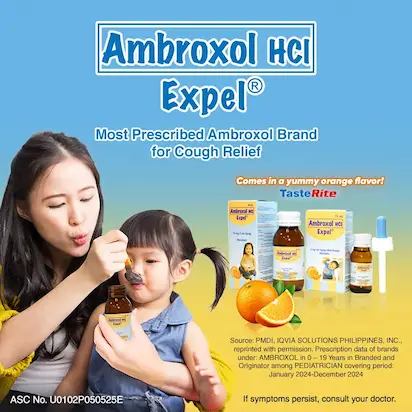What’s worse—hearing your children cough nonstop at 2 a.m. or watching them cry as they try to spit out phlegm? For most of you parents, it’s not even a question. The answer is usually both. The worry and helplessness are real.
But here’s something you might like to know: that wet, rattly cough you’re hearing is often a good sign. It means your child’s body is working hard to clear out the phlegm.
So, what exactly causes this kind of cough, and when should you worry? Find out in this short read!
What is a Productive Cough?
A productive cough—also called a wet or chesty cough—is a type of cough that produces mucus or phlegm (also known as sputum). If your child has one, you might notice their cough sounds heavy. They may even experience chest congestion, a tight or full feeling in the chest.
Why Do Kids Get Productive Cough Often?
Here are some reasons why your little ones might seem to catch a productive cough more often than others.
1. Frequent Exposure to Germs and Viruses
From the moment your kids step out of your house, they’re exposed to different illness-causing germs. Whether they’re in a classroom learning, attending extracurricular activities, or just enjoying a simple playtime at the park, they encounter countless surfaces and people daily.
2. Developing Immune System
Your kids' immune systems are still developing and haven’t built up defenses against common infections that they come in contact with. As a result, their bodies are more likely to react with symptoms like coughing.
3. Still Learning the Basics of Hygiene
Young children are still learning the ropes when it comes to good hygiene habits like handwashing and covering their mouths when they cough. At this stage, their focus is often on play and exploration—which is perfectly natural! While they’re still getting used to regular hygiene practices, children can be more prone to catching and passing on infections like a productive cough.
What’s Behind their Cough with Phlegm?
How do your kids' productive cough develop? Find out in the list below.
1. Viral Infections (Common Colds and Flu)
Whenever your kid gets infected by a cold or flu, the body releases chemicals to fight off the infection. These chemicals can cause swelling in the airways. This inflammation leads to extra mucus being produced.
Why mucus? Mucus helps trap and flush out the virus and other particles (like dust or allergens) that might be present in the airways. It's the body's way of protecting the lungs and airways from further irritation and infection. Hence, it is important to expel phlegm to prevent the worsening of the cough.
2. Acute Bronchitis
The bronchial tubes ensure that air flows through the lungs efficiently. They carry fresh air into the lungs while expelling carbon dioxide.
Acute bronchitis is a relatively short-term illness that typically results from a viral infection. It is often caused by the same viruses that cause the common cold or the flu. The infection leads to inflammation in the bronchial tubes, which causes the production of mucus.
3. Environmental Irritants
Exposure to environmental irritants such as air pollution, or strong cleaning products can lead to a productive cough in children. Children with sensitive airways, such as those with asthma, may be especially vulnerable.
In addition to a productive cough, other symptoms of allergies may include:
- Sneezing
- Itchy or watery eyes
- A runny nose
- Scratchy throat
What You Can Do to Help Your Kid!
Here are some tips to help your child cope with a productive cough.
- Keep them hydrated! Give your child lots of fluids like water or fresh juice to help thin out mucus.
- Avoid smoke and strong smells. Keep your child away from smoke, perfumes, or anything that irritates their throat.
- Comfort and distract them. Offer a soft blanket, play a calming song, or read them a book to help them relax and take their mind off the cough.
While these tips can help your child feel more comfortable, they’re just meant to support their recovery. To help treat their productive cough, it’s still best to check in with your pediatrician. Moreover, they may prescribe a mucolytic—a type of medicine that helps loosen and clear out mucus.
One option that you can consider is Ambroxol HCl (Expel®)!
Ambroxol HCl (Expel®) is used for the relief of cough secondary to acute and chronic diseases of the respiratory tract accompanied by excessive lung secretions such as chronic bronchitis, asthmatic bronchitis, and bronchial asthma.
It contains ambroxol, which helps break down mucus resulting in the production of less thick and less sticky mucus or phlegm. Ambroxol also aids in improving mucociliary clearance (mucus flow and transport), making phlegm easier to cough up and expel. Additionally, Expel has a yummy orange flavor (formulated with TasteRite Technology) for children who dislike a bitter taste, helping parents ensure that their kids take their medicine.
Suggested Usage
Ambroxol HCl (Expel®) should be taken orally (by mouth), as recommended by the doctor.
Babies 6 months and younger:
- 0.5 mL of the 6 mg/mL oral drops every 12 hours
Babies 7 to 12 months old:
- 1 mL of the 6 mg/mL oral drops every 12 hours
Toddlers 1 to 2 years old:
- 1.25 mL of the 6 mg/mL oral drops or 2.5 mL or half a teaspoon of the 15 mg/5 mL syrup, every 12 hours
Children 3 to 6 years old:
- 2.5 mL half a teaspoon of the cough syrup every 8 hours
Kids 7 to 12 years old:
- 5 mL (1 teaspoon) of the cough syrup every 8 to 12 hours
If symptoms persist, consult a doctor.
ASC Ref. No. U0060P052325E
References:
https://my.clevelandclinic.org/health/symptoms/17755-cough
https://www.allinahealth.org/healthysetgo/heal/4-types-of-coughs-and-when-to-seek-treatment
https://pmc.ncbi.nlm.nih.gov/articles/PMC4148026/#:~:text=The%20cough%20reflex%20is%20modulated,first%20few%20years%20of%20life.
https://www.ncbi.nlm.nih.gov/books/NBK359/
https://theendocrineco.com/when-is-a-childs-immune-system-fully-developed/
https://www.universityhealth.com/blog/why-do-my-kids-keep-getting-sick
https://pmc.ncbi.nlm.nih.gov/articles/PMC8869967/
https://health.choc.org/kids-and-germs-what-parents-should-know/



